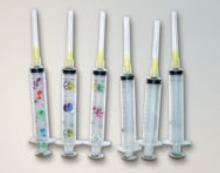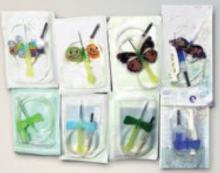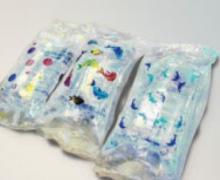- Adding decorative designs or stickers to medical devices before a procedure significantly reduces aversion, fear, and anxiety, and may be especially useful for needle-phobic patients (A).
Needle phobia—fear of needles, syringes, intravenous therapy, and medical devices—can seriously compromise medical care.1-7 We hypothesized that a novel cognitive therapy consisting of simple designs and decorations on needles and other medical devices would reduce needle phobia. Fear, aversion, and anxiety decreased significantly—as measured by validated visual analogue reaction scales—when patients were exposed to decorated devices.
Materials and methods
Subjects
This was a randomized controlled trial approved by the Institutional Review Board (IRB). Sixty patients were recruited from outpatient clinics: 67% female, 33% male, 100% outpatients, 41% pediatric patients, and 59% adults—representing the typical mix of subjects in a family practice clinic. The mean age of the patients was 32±21 years (range, 3 years to 65 years).
After informed consent, the subjects were randomly exposed to 8 different designs of winged needles and 6 different designs of syringes fitted with a needle. Smaller subsets of subjects were exposed to different designs of intravenous (IV) bags and scalpels.
Stress-reducing needles and syringes
Stress-reducing syringes were created by taking conventional 10-mL syringes (10-mL Luer-Lok BD syringe, ref 309604, Becton Dickinson, Franklin Lakes, NJ) and decorating them so that the markings of the barrel could still be seen (FIGURE 1). Stress-reducing winged catheters (21 G 3/4×12-inch 367281 Vacutainer brand Safety-Lok Blood Collection Set; Becton Dickinson, Franklin Lakes, NJ) were created by decorating the wings in a symmetrical manner (FIGURE 2). Similarly, different designs of IV bag (FIGURE 3) and scalpel were used.
FIGURE 1
Stress-reducing syringes
Stress-reducing syringes (compared with 3 typical conventional syringes at right) yielded a mean 79% decrease in aversion scores, 53% decrease in fear scores, and 51% decrease in anxiety scores. Musical notes were the most favored design (P<.001).
FIGURE 2
Stress-reducing butterfly needles
Stress-reducing butterfly needles (compared with 4 typical designs at bottom) reduced aversion by 68%, fear by 53%, and anxiety by 53% (P<.001).
FIGURE 3
Stress-reducing IV bags
Stress-reducing intravenous bags reduced aversion by 83%, fear by 53%, and anxiety by 73% (P<.001).
Outcome measures
For each group of devices, the presentation of individual devices to each subject was randomized to eliminate the possibility of a consistent bias. Emotional responses to the medical devices were determined with the validated visual analogue reaction scales where 0 is lowest response and 10 is the strongest.8-11 These included the Visual Analogue Anxiety Scale (VAAS), Visual Analogue Fear Scale (VAFS), and Visual Analogue Aversion Scale (VAS). Significant needle phobia was defined as an aversion, fear, or anxiety score of greater than or equal to 5.
Statistical analysis
Primary analyses consisted of comparing the responses to the stress-reducing devices as a class with the conventional devices as a class. These paired data were compared with the paired 2-tailed t-test. To determine whether these responses were class-specific or design-specific, the results for each individual device were then compared with a matched control, design by design, again with the paired 2-tailed t-test. Corrections were made for multiple comparisons.
Results
Patients experienced markedly more aversion to (dislike of) conventional syringes (VAAS score: 5.88±3.61 vs stress-reducing syringes VAAS score: 1.21±1.64; P<.001); they also had greater fear (conventional VAFS score: 4.68±2.8 vs stress-reducing VAFS score: 2.19±2.8, P<.001) and anxiety (conventional VAS score: 4.54±3.68 vs stress-reducing VAS score: 2.21±2.84, P<.001) (TABLE). This corresponds to a mean 79% decrease in aversion scores, 53% reduction in fear scores, and 51% decrease in anxiety scores with the stress-reducing syringes. Ninety-five percent of subjects preferred the stress-reducing syringes to the conventional syringes; 98% of subjects felt that stress-reducing syringes should be available for children; 72% felt that the stress-reducing syringes should also be available for adults.
The syringes most favored were those with musical notes (56%), flowers (18%), and smiley faces (12%). Each of these designs had lower scores in the 3 domains (fear, aversion, and anxiety) compared with the conventional device (P<.01), indicating that the reduction in stress measures was a class effect, rather than a specific effect of the individual design.
Significant needle phobia is defined as aversion, fear, or anxiety scores ≥5. Using this definition, 80% of subjects experienced moderate to severe aversion, 63% suffered moderate to severe fear, and 62% experienced moderate to severe anxiety on exposure to conventional syringes. This corresponded to mean aversion, fear, and anxiety scores of 7.18±1.92, 6.98±2.16, and 6.78±2.44, respectively. In subjects with significant needle phobia, stress-reducing syringes reduced aversion scores by 81% (P<.001), fear scores by 56% (P<.001), and anxiety by 47% (P<.001). Stress-reducing syringes had a positive response rate of 98% for reducing aversion, 87% in reducing fear, and 74% in reducing anxiety.




